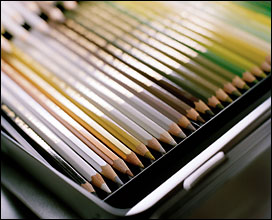Light fastness ratings explained
Dr. Eric Vitus explains the two systems for rating light fastness

The range of 76 LUMINANCE rated LFI and LFII is currently the only coloured pencil or crayon product which fully complies to the international ASTM D6901-06 standard of lightfastness, applied to the final product and not only on its ingredients.
Since 2003, this standard of the American material testing organization (ASTM) has quantified the difference in colour between two sets of specimens both before and after exposure to the light, - direct sunlight and at least 150h of Xenon arc light.
Lightfastness I (LFI = excellent) and lightfastness II (LFII = very good) coloured pencils offer long-lasting artworks for 100 years or more under normal museum conditions.

More common among Coloured Pencil producers is to rate the lightfastness of their own pencils on the basis of the 'Blue Wool Scale'. This British standard was introduced by the textile industry and later adapted for the printing and painting industry.
Graduation on the 'Blue Wool Scale' is from 1 to 8, with level 1 being the lowest value.
Level 2 takes twice as long to fade as 1. Level 3 is double the time of level 2, and so on.
Normally this test takes place in the laboratory of the producer, and happens by exposing paper strips with applied colour to100h under Xenon UV-light. Generally, colours with level 6 and more are considered as very trustworthy.
To simplify their communication, some producers indicate the lightfastness with a number of stars, based on the Blue Wool Scale :
• 5-stars rating system : ***** (7+8 = means excellent on the Blue Wool Scale), **** (6 = very good), *** (5+4 = good), ** (2+3 = feeble) and * (1 = poor)
Since 2000, Caran d’Ache has marked artists pencils like MUSEUM Aquarelle or PASTEL PENCIL according to this scale.
• 3-stars rating system : *** (7+8 = means excellent on the « Blue Wool Scale »), ** = (5+6 = good + very good) and * (3+4 = fair + moderate)
Since the late 80s, Caran d’Ache has marked artists colour pencils like SUPRACOLOR, PABLO and PRISMALO according to this scale.

If you can’t find any indications about lightfastness on the pencils bodies or colour charts or on the websites of the producers, be careful when choosing your colours for your artwork.
Simple marketing claims like 'Lightfast' or 'incredible lightfastness' are not trustworthy information sources for serious users.
A 100% lightfast pigment only exists in theory.
In practice, UV, Pigments, by their nature, tend to decompose and to fade under light exposure. Also, acids and other influences constantly 'attack' and alter the chemical structure of the pigment molecules. Colours non only fade, but also darken or turn grey.
If the quality of the chosen colours is unsufficient, drawings or paintings can look dramatically different to when they were first created.
Pay attention with non-pigmented inks that are added to colour, graphite or charcoal products, as they often show bright colours on the first sight, but quite quickly fade. Notice that not only the choice of the pigments influences the lightfastness of a colour, but also the binding agent and the way the colours are applied :
- Dry or wet?
- In thin or thick layers?
- On acid or non-acid surface?
Generally, a wax enrolled pigment will be more protected against UV light than a 'free' pigment particle. Also, a pencil coloured layer can partly be protected with a waxy blender, with an anti UV protecting spray, or by framing the artwork with an anti UV glass. Thanks to newer generations of chemically produced synthetic pigments, artist colours become more and more long-lasting, which is also good news for coloured pencil artists.
Forgotten are the years when museum directors, gallerists and art collectors refused to purchase colour pencil artworks because of fading colours. With serious and transparent information and technical efforts, manufacturers, artists and publishers can help trusting in this wonderful, versatile medium.
And by the way, graphite pencil artists have nothing to fear at all, as graphite is not a pigment but microcrystallized carbon, which by heat and under huge pressure was transformed into a precious and absolutely non-fading, shiny, natural powder.











Comments
Login or register to add a comment